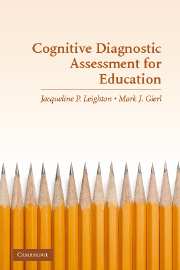Book contents
- Frontmatter
- Contents
- List of Contributors
- PART I THE BASIS OF COGNITIVE DIAGNOSTIC ASSESSMENT
- 1 Why Cognitive Diagnostic Assessment?
- 2 The Demand for Cognitive Diagnostic Assessment
- 3 Cognitive Modeling of Performance on Diagnostic Achievement Tests: A Philosophical Analysis and Justification
- 4 Test Validity in Cognitive Assessment
- PART II PRINCIPLES OF TEST DESIGN AND ANALYSIS
- PART III PSYCHOMETRIC PROCEDURES AND APPLICATIONS
- Author Index
- Subject Index
- References
1 - Why Cognitive Diagnostic Assessment?
Published online by Cambridge University Press: 23 November 2009
- Frontmatter
- Contents
- List of Contributors
- PART I THE BASIS OF COGNITIVE DIAGNOSTIC ASSESSMENT
- 1 Why Cognitive Diagnostic Assessment?
- 2 The Demand for Cognitive Diagnostic Assessment
- 3 Cognitive Modeling of Performance on Diagnostic Achievement Tests: A Philosophical Analysis and Justification
- 4 Test Validity in Cognitive Assessment
- PART II PRINCIPLES OF TEST DESIGN AND ANALYSIS
- PART III PSYCHOMETRIC PROCEDURES AND APPLICATIONS
- Author Index
- Subject Index
- References
Summary
Cognitive diagnostic assessment (CDA) is designed to measure specific knowledge structures and processing skills in students so as to provide information about their cognitive strengths and weaknesses. CDA is still in its infancy, but its parentage is fairly well established. In 1989, two seminal chapters in Robert Linn's Educational Measurement signaled both the escalating interest in and the need for cognitive diagnostic assessment. Samuel Messick's chapter, “Validity”, and the late Richard Snow and David Lohman's chapter, “Implications of Cognitive Psychology for Educational Measurement”, helped solidify the courtship of cognitive psychology within educational measurement. The ideas expressed in these chapters attracted many young scholars to educational measurement and persuaded other, well-established scholars to consider the potential of a relatively innovative branch of psychology, namely, cognitive psychology, for informing test development.
CDA can be traced to the ideas expressed in the previously mentioned chapters and, of course, to the many other authors whose ideas, in turn, inspired Messick, Snow, and Lohman (e.g., Cronbach, 1957; Cronbach & Meehl, 1955; Embretson, 1983; Loevinger, 1957; Pellegrino & Glaser, 1979). Since 1989, other influential articles, chapters, and books have been written specifically about CDA (see Frederiksen, Glaser, Lesgold, & Shafto, 1990). Most notably, the article by Paul Nichols (1994) titled “A Framework for Developing Cognitively Diagnostic Assessments” and the book coedited by Paul Nichols, Susan Chipman, and Robert Brennan (1995) appropriately titled Cognitively Diagnostic Assessment.
- Type
- Chapter
- Information
- Cognitive Diagnostic Assessment for EducationTheory and Applications, pp. 3 - 18Publisher: Cambridge University PressPrint publication year: 2007
References
- 36
- Cited by



